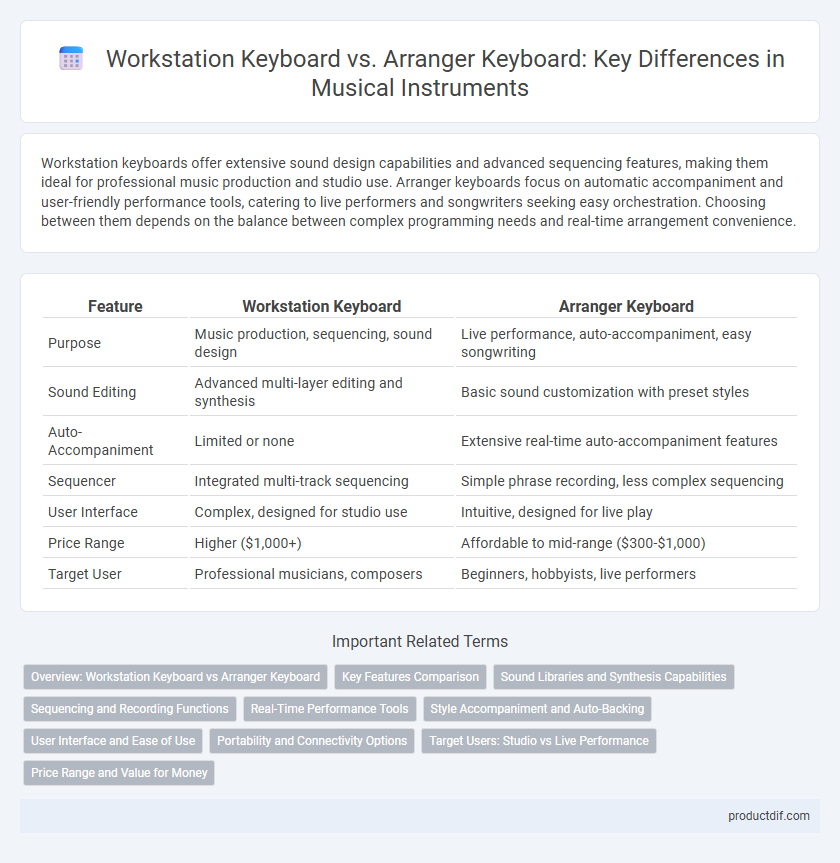Workstation keyboards offer extensive sound design capabilities and advanced sequencing features, making them ideal for professional music production and studio use. Arranger keyboards focus on automatic accompaniment and user-friendly performance tools, catering to live performers and songwriters seeking easy orchestration. Choosing between them depends on the balance between complex programming needs and real-time arrangement convenience.
Table of Comparison
| Feature | Workstation Keyboard | Arranger Keyboard |
|---|---|---|
| Purpose | Music production, sequencing, sound design | Live performance, auto-accompaniment, easy songwriting |
| Sound Editing | Advanced multi-layer editing and synthesis | Basic sound customization with preset styles |
| Auto-Accompaniment | Limited or none | Extensive real-time auto-accompaniment features |
| Sequencer | Integrated multi-track sequencing | Simple phrase recording, less complex sequencing |
| User Interface | Complex, designed for studio use | Intuitive, designed for live play |
| Price Range | Higher ($1,000+) | Affordable to mid-range ($300-$1,000) |
| Target User | Professional musicians, composers | Beginners, hobbyists, live performers |
Overview: Workstation Keyboard vs Arranger Keyboard
Workstation keyboards integrate advanced sound synthesis, sequencing, and recording features, making them ideal for professional music production and performance. Arranger keyboards focus on real-time accompaniment with automated rhythms and harmonies, designed for solo performers and live events. Both offer versatile capabilities, but workstations emphasize music creation while arrangers prioritize easy live arrangement and performance.
Key Features Comparison
Workstation keyboards offer advanced sound synthesis, extensive sequencing capabilities, and customizable effects, making them ideal for music production and studio work. Arranger keyboards focus on real-time accompaniment with built-in styles and automatic chord detection, catering to live performers and songwriters seeking ease of use. Both feature weighted or semi-weighted keys, but workstations often provide more polyphony and connectivity options such as MIDI and audio interfaces.
Sound Libraries and Synthesis Capabilities
Workstation keyboards offer extensive sound libraries with highly editable synthesis capabilities, allowing musicians to create complex, layered sounds through advanced sampling and synthesis engines. Arranger keyboards feature curated sound libraries optimized for immediate playback and style-based accompaniment, prioritizing ease of use over deep sound manipulation. The synthesis in workstations supports detailed sound design and integration with external hardware, whereas arrangers focus on pre-programmed sounds tailored for live performance and songwriting convenience.
Sequencing and Recording Functions
Workstation keyboards offer advanced sequencing and recording functions, enabling complex multi-track arrangements and extensive editing capabilities ideal for professional music production. Arranger keyboards provide more simplified sequencing tools with built-in accompaniment styles, designed for live performance and quick song creation. Workstations typically support MIDI sequencing and pattern-based recording, offering greater flexibility than the pattern-focused, style-driven recording found in arrangers.
Real-Time Performance Tools
Workstation keyboards offer advanced real-time performance tools such as customizable MIDI controls, multi-timbral sequencing, and deep sound design capabilities, enabling musicians to manipulate complex arrangements on the fly. Arranger keyboards focus on intuitive live performance with built-in accompaniment styles, chord recognition, and automatic phrase triggering to support solo performers or small ensembles. The choice between workstation and arranger keyboards depends on the need for sophisticated sound editing or seamless live accompaniment features.
Style Accompaniment and Auto-Backing
Workstation keyboards offer advanced style accompaniment with customizable auto-backing features, enabling musicians to create intricate arrangements and layer multiple instrument sounds for professional-level music production. Arranger keyboards provide user-friendly style accompaniment with automated auto-backing, ideal for live performances and solo playing by automatically generating chords and rhythm patterns based on the player's input. The sophisticated auto-backing capabilities in workstations support deeper control over tempo, dynamics, and effects, surpassing the more preset-driven and performance-oriented auto-backing found in arranger keyboards.
User Interface and Ease of Use
Workstation keyboards feature advanced user interfaces with customizable touchscreens and extensive control options, catering to professional musicians who require deep sound editing and sequencing capabilities. Arranger keyboards prioritize ease of use with intuitive interfaces, dedicated style controls, and automated accompaniment features that allow beginners or performers to quickly create full arrangements. The user experience on arranger keyboards is streamlined for live performance and songwriting, while workstations offer a complex environment suited for detailed production and sound design.
Portability and Connectivity Options
Workstation keyboards typically offer extensive connectivity options such as USB, MIDI, and audio interfaces, enabling seamless integration with external devices and software, though they tend to be heavier and less portable due to their robust build and advanced features. Arranger keyboards prioritize portability with lighter designs and built-in speakers, making them ideal for live performances and mobile use, but often have fewer connectivity options compared to workstations. Musicians seeking a balance between portability and connectivity must consider the trade-off between workstation keyboards' comprehensive interfaces and arrangers' ease of transport.
Target Users: Studio vs Live Performance
Workstation keyboards are tailored for studio musicians and producers, offering advanced sound design, sequencing, and extensive control features essential for music production and composition. In contrast, arranger keyboards cater to live performers who need real-time accompaniment, automatic chord recognition, and versatile rhythm patterns to enhance on-stage performances. Target users for workstations prioritize deep customization and integration with digital audio workstations, while arranger users focus on ease of use and spontaneous musical expression during concerts or events.
Price Range and Value for Money
Workstation keyboards typically range from $1,000 to $3,000, offering advanced sound design, sequencing, and sampling capabilities that provide exceptional value for professional producers and composers. Arranger keyboards, priced between $500 and $1,500, focus on real-time accompaniment and ease of use, delivering great value for live performers and hobbyists seeking versatile preset styles. Choosing between them depends on whether the priority is comprehensive production features or affordability combined with user-friendly performance tools.
Workstation keyboard vs Arranger keyboard Infographic

 productdif.com
productdif.com